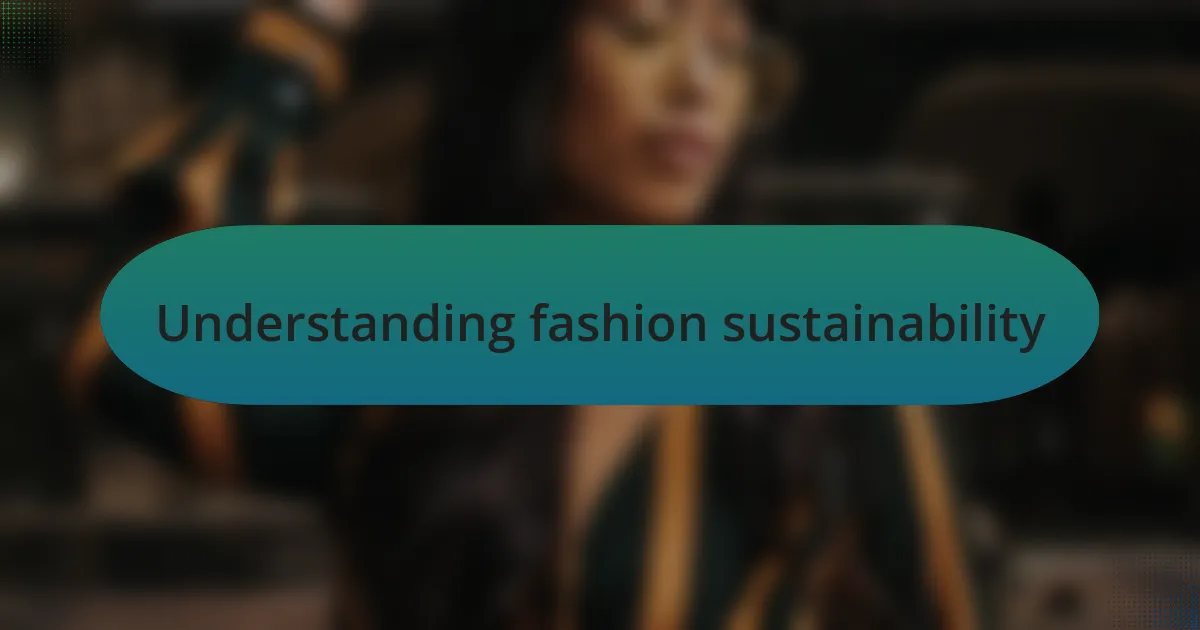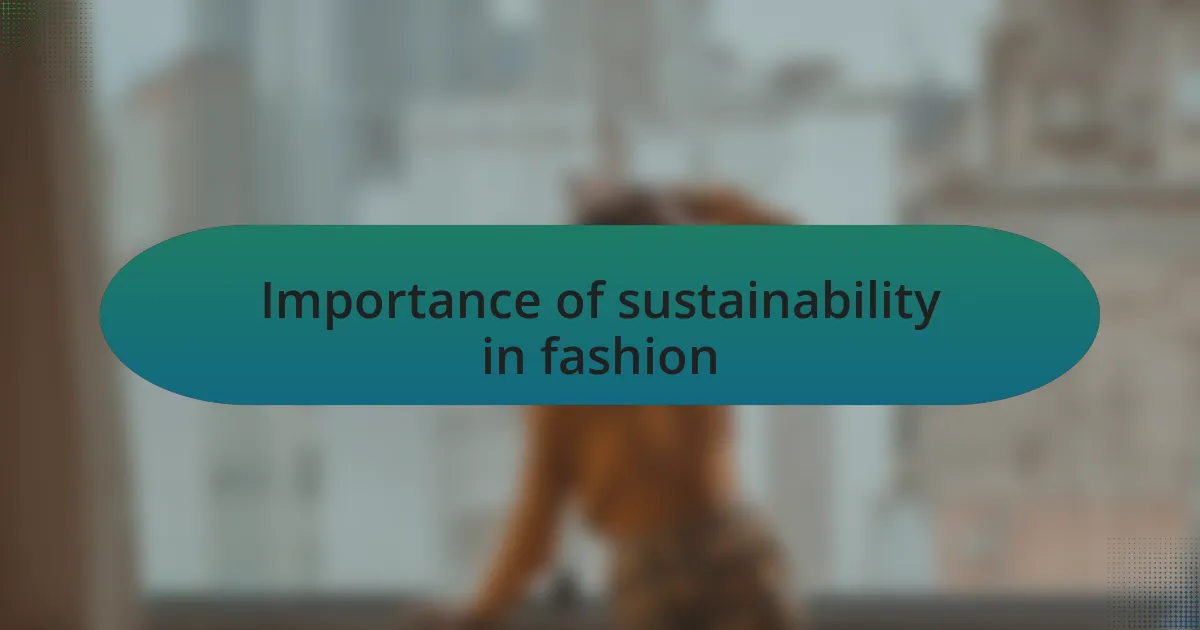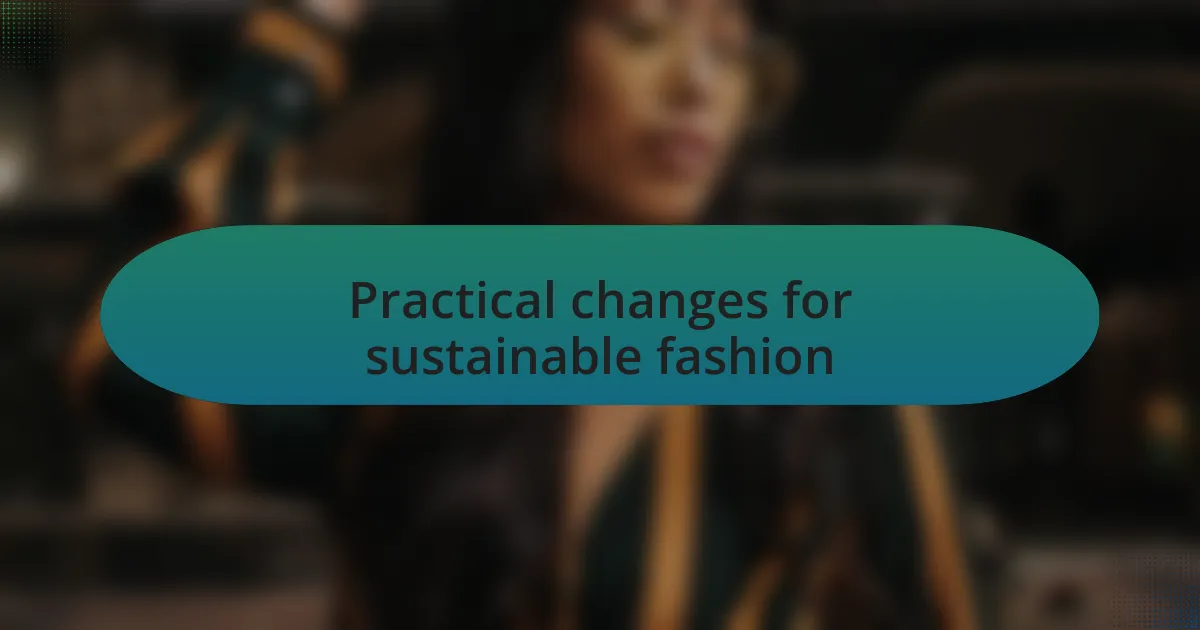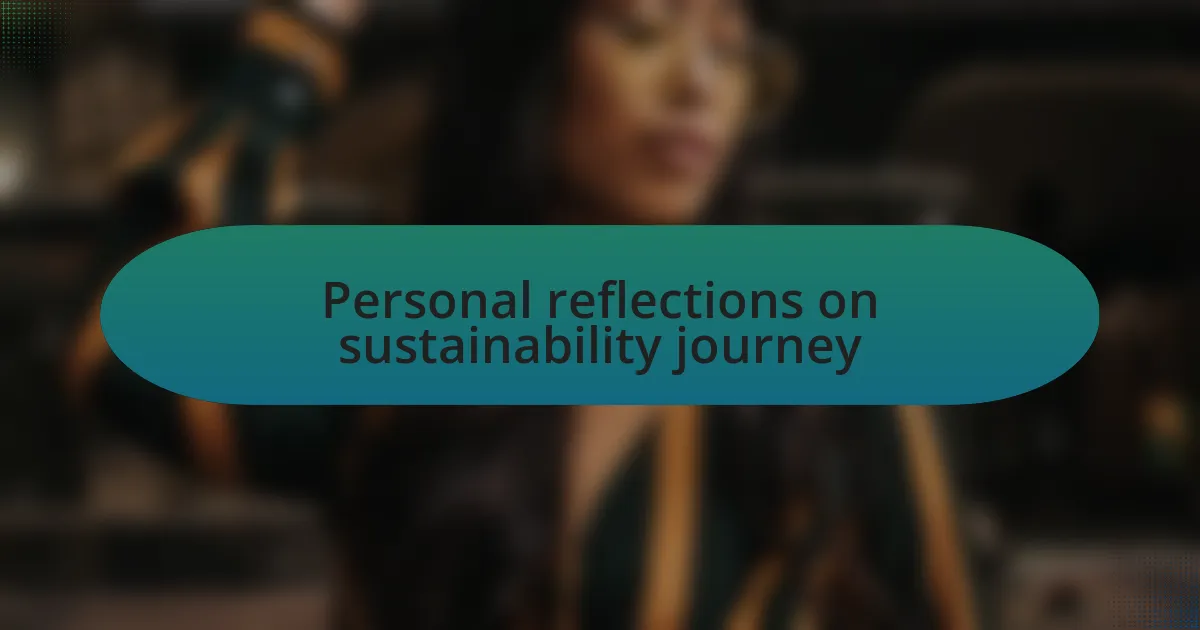Key takeaways:
- Sustainability in fashion involves a holistic approach, considering the entire lifecycle of garments, from production to disposal.
- Documentaries reveal the contrast between fast fashion and sustainable practices, emphasizing the importance of transparency in supply chains.
- Mindful consumption can reshape consumer behavior, encouraging choices that reflect personal values and support ethical brands.
- Practical changes like buying less, choosing quality, and properly caring for clothes can significantly reduce fashion’s environmental impact.

Understanding fashion sustainability
Understanding fashion sustainability goes beyond just eco-friendly materials; it’s about rethinking our entire approach to the industry. I remember sitting down to watch a documentary that opened my eyes to how much water is used in conventional cotton farming. Can you imagine the impact we could have if we shifted our focus to organic cotton or even innovative materials like hemp?
One of the most striking lessons I’ve learned is that the impact of fashion doesn’t end once we purchase an item. When I reflect on my shopping habits, I realize how often I’ve been tempted by fast fashion trends that offer low-cost items but come with hidden costs to the environment. It makes me wonder: how many pieces of clothing do we truly need to feel fulfilled?
Diving deeper into the world of sustainable fashion has revealed the power of upcycling. I once transformed an old pair of jeans into a bag, which felt like a small victory against wastefulness. It’s a great reminder that sustainability offers creativity and innovation; instead of discarding, we can recycle. What if we all embraced this mindset and viewed our wardrobes as a canvas for personal expression and environmental responsibility?

Importance of sustainability in fashion
Sustainability in fashion is crucial because it directly impacts our planet’s health. After watching a thought-provoking documentary, I realized how a single garment’s production can produce tons of waste and pollution. It hit me personally; I started to question the true cost of those trendy outfits I once bought without a second thought.
Another lesson I gleaned is how sustainable practices can empower communities. I recall seeing artisans in developing countries, using traditional methods to create beautiful, eco-friendly garments. Watching them work reminded me that fashion isn’t just about aesthetics; it’s about the stories and livelihoods behind our clothes. This connection fosters a deeper appreciation and makes me consider where and how every piece I purchase has been made.
Moreover, embracing sustainability can reshape consumer behavior. Reflecting on my experience, I’ve become much more mindful of my wardrobe choices. I often ask myself, am I contributing to a cycle of waste or supporting a sustainable and ethical approach? This shift in mindset has not only made me a more responsible consumer but has also enriched my relationship with fashion by aligning it with my values.

Key themes in fashion documentaries
Documentaries on fashion often highlight the stark contrast between mass production and sustainable practices. I remember one striking scene where the film showcased a factory spewing pollution right next to a lush, vibrant community. It was alarming to realize how the fashion industry’s approach to speed and cost can devastate the very environments we cherish. Have you ever thought about the invisible costs associated with fast fashion?
Another recurring theme I observed is the importance of transparency in the supply chain. In one documentary, a designer bravely unveiled her sources, showing viewers the journey of materials from farm to fabric. This resonated with me deeply; it made me reconsider brands that often shy away from sharing their processes. I found myself wondering: if a brand is proud of its practices, why wouldn’t they share them openly?
Lastly, the narratives around consumerism took center stage in many films I watched. I reflected on my own shopping habits while witnessing consumers in the documentaries make intentional choices, like swapping clothes instead of buying new ones. Their joy in finding sustainable solutions prompted me to rethink my approach as well. It raised a thought-provoking question: What if our fashion choices could be acts of kindness towards the earth?

Lessons learned from fashion documentaries
One lesson that struck me was the power of craftsmanship showcased in these documentaries. I recall watching a film that followed artisans creating handmade garments, and it was a revelation. The attention to detail and the pride in their work made me realize how much soul is embedded in sustainable fashion. It left me pondering: what stories do my clothes tell about their origins?
Another significant takeaway was the impact of fashion’s footprint on communities. I remember seeing the consequences of factory closures, where entire neighborhoods fell into economic uncertainty. It tugged at my heartstrings and made me reflect on how my fashion choices could influence livelihoods around the world. It raises an essential question: how can we advocate for brands that positively impact communities?
Lastly, I was moved by the call for mindful consumption. There was a powerful moment in one documentary where a consumer talked about her decision to purchase only second-hand clothing for a year. Her journey inspired me and prompted me to consider how I approach my wardrobe. What if we all consciously chose quality over quantity, making our fashion selections a statement of our values?

Practical changes for sustainable fashion
When it comes to making practical changes for sustainable fashion, I began to explore my purchasing habits. I decided to adopt a “buy less, choose well” philosophy, where I focus on quality items that are versatile and timeless. This shift not only transformed my wardrobe but also elevated my understanding of the fashion industry’s environmental impact. How much waste could we reduce if everyone made similar choices?
Another change I’ve embraced is supporting local and sustainable brands. On a recent shopping trip, I discovered a small boutique that emphasized ethical sourcing and fair labor practices. This experience was eye-opening for me; it made me feel connected to the artisans behind the clothes I wear. I often wonder: isn’t it better to invest in pieces that tell a story rather than contribute to the fast fashion cycle?
I also started to educate myself on garment care. I realized that properly caring for clothes can extend their lifespan significantly. For instance, I now hand wash many of my favorite garments instead of tossing them in the dryer. This small act not only preserves the fabric but also makes me feel more responsible for my choices. Have you ever considered how a little extra care could make a big difference in your wardrobe?

Personal reflections on sustainability journey
As my journey into sustainability deepened, I found myself reflecting on the profound connection between fashion and self-identity. I once wore fast fashion without considering the ethics behind it, but now, the clothes I choose feel like an extension of my values. How transformative is it to wear something that resonates with your beliefs? When I slipped into a sustainably made dress for the first time, it felt like reclaiming not just my style, but also my conscience.
There was a moment when I was invited to a local fashion event promoting sustainable designs. I expected to just enjoy the experience, but instead, it ignited a passion within me. Listening to designers share their stories about sourcing materials responsibly made me realize that every piece has a narrative. Why should we not support those stories? It’s exhilarating to think that my choices could contribute to a larger movement, one that embraces creativity without compromising the planet.
My emotional connection to sustainability has led me to become more aware of how I discard clothing. A few months ago, I held onto an old sweater, contemplating its fate. Instead of tossing it, I decided to transform it into a decorative pillow. This small act of repurposing not only saved it from the landfill but also filled my home with a memory. Have you ever found a way to breathe new life into what you thought was waste? It’s moments like these that continually motivate me to think creatively about fashion and sustainability.